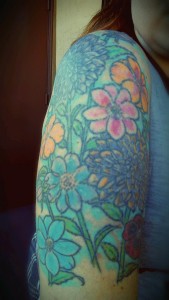
Scars come with stories. They can be badges of honor, the result of an adventure or some sort of valiant act. But they also can serve as a representation of a dark or painful time, something the scar bearer would rather forget or transform into something new. Tattoos can help accomplish this by turning something painful into a beautiful work of art in a type of catharsis.
I spoke to a woman named Tina, who used the power of tattoos to take back her body after a mastectomy. After declining rebuilding nipples in her breast reconstruction, she opted to have them tattooed on, a procedure she has done every year. She says the tattoos don’t just cover the scars, but instead serve them.
“It made other people uncomfortable when I went to the gym or doctor office or waxing lady or for massage treatments,” she said of her absence of nipples. “Without anatomical parts, people ask if I was born on earth. Sad but true.”
Another trend in tattoo cover-ups involve covering C-section scars. Some mothers with C-section scars feel insecure about them and want them covered. Others consider it a “souvenir” of childbirth and choose a tattoo to commemorate their child’s arrival. Getting a tattoo can be a way for a woman to reclaim her postpartum body, and a tattoo can serve as a celebration of this important life event.
Even burn marks are a great canvas for a tattoo. For instance, I spoke to a woman named Mollie who picked a butterfly to go on her back after a burn injury. She mentioned feeling pressure to cover it, desiring to conceal her wound effectively.
“To be honest, I wish I had put more thought in what I wanted to cover the scar. Or that the tattoo artist had offered up additional suggestions.”
It’s an understandable pressure, as rebuilding or covering a scar not only creates a more aesthetically pleasing look, but also can completely change how that person is viewed by others. In Tina’s case, it was about her desire to be seen as human by others after her surgery. In other situations, it was the need to conceal a reminder of pain.
It’s very common for one who has recovered from self-harming to demonstrate their newfound strength through their tattoos. One person, who prefers to remain anonymous, talked of their cover-up tattoo.
“I got it as a way to remind myself of my strength,” they said. “I picked the spot on my arm that I used to frequently self-harm. I got words tattooed there that may not mean much to others, but allow me to remember my pain. It actually keeps me from cutting.”
Several others stepped forward to tell the stories of their self-harm cover-ups. One young woman, Ana, chose to get her scars covered with the Rebel Alliance symbol from the Star Wars series. This tattoo matches those of her other family members, making it “not only a tribute to her fandom, but also to family.”
RI resident Kayla, who has a music-themed tattoo that covers her self-harm scars, says that these kinds of tattoos symbolize new beginnings. “Covering the remnants of what was a really bad time in my life for me with things that are positive, silly and weird has been really healing for me.”
Similarly, another woman, Kera, got an assortment of dahlias on her bicep, where her self-harm was most evident. It symbolizes her commitment to her mental health, both for herself and to her loved ones.
“Given that it’s also in a highly visible location, it helps to quell looks and questions of misunderstanding regarding my scars at inappropriate times,” Kera says. “Not that I mind talking about my history with self injury, just not in situations like if I’m at work and would prefer subjects to say professional.”
Many tattoos have a story and represent some part of a person’s life. They can serve as reminders of battles lost and won. Whether a cover-up emphasizes or negates a mark on one’s body, it is ultimately an exercise in taking back their physical being and a symbol of their emotional recovery.


